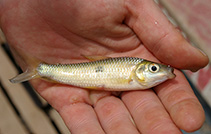| Family: |
Anostomidae (Headstanders) |
| Max. size: |
18.95 cm SL (male/unsexed) |
| Environment: |
benthopelagic; freshwater |
| Distribution: |
South America: throughout the Río Orinoco drainage in Venezuela, including the ríos Caura, Pamoni, Casiquiare, Manapiare, and Ventuari. |
| Diagnosis: |
Dorsal soft rays (total): 12-12; Anal soft rays: 10-10; Vertebrae: 38-38. Leporinus arimaspi is distinguished from all other congeners except L. aripuanaensis, L. amazonicus, L. apollo, L. cylindriformis, L. niceforoi, and L. ortomaculatus by the combination of an extremely dorsoventrally slender body (body depth immediately anterior to the dorsal-fin origin of 19-27% SL, versus 29% SL or greater) and the pigmentation pattern consisting of one or more dark spots centered along the lateral-line scale row. It differs from L. apollo, L. cylindriformis, L. niceforoi, and L. ortomaculatus by the lack of the dark spot along the lateral-line posterior to the dorsal-fin insertion and anterior to the adipose-fin origin (vs. presence of an intense dark spot). It further differs from L. apollo and L. cylindriformis by having five upper transverse scale rows (vs. six in most specimens), and four lower transverse scale rows (vs. five in most specimens), and from L. ortomaculatus by the absence of rows of spots dorsal and ventral to the lateral-line scale row (vs. presence); from L. amazonicus by having 37- 40 total scales on lateral line (vs. 43–45), 38 vertebrae (vs. 41), and four lower transverse scale rows at the pelvic-fin insertion (vs. 5 in most specimens). It is readily distinguished from the most similar species, L. aripuanaensis, by the absence (or faint presence) of a circular dark spot over the hypural plate (vs. presence of an intensely pigmented dark spot in that position). It can be further diagnosed from L. aripuanaensis by having 12 modal predorsal scales (vs. 11), as well as the following morphometrics in specimens between 7.0 and 9.2 cm SL: interorbital width 34-44% HL (vs. 29-34% HL) and eye diameter 29-34% HL (vs. 25-30% HL) (Ref. 96504).
Description: Dorsal- fin rays ii-10; anal-fin rays ii-8; pectoral-fin rays i-15-16; pelvic-fin rays i-8; presence of transverse dark bars along dorsum and continuing ventrally, ventral portion of bars much fainter than dorsal portion (Ref. 96504). |
| Biology: |
Found in rivers. Some specimens were collected near bedrock outcroppings and banks (Ref. 96504). |
| IUCN Red List Status: |
Least Concern (LC); Date assessed: 16 November 2020 Ref. (130435)
|
| Threat to humans: |
harmless |
| Country info: |
|
Source and more info: www.fishbase.org. For personal, classroom, and other internal use only. Not for publication.

